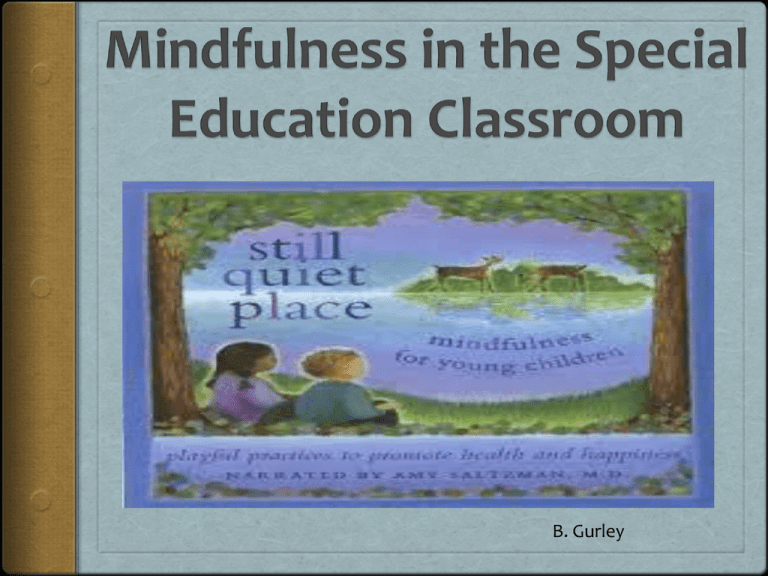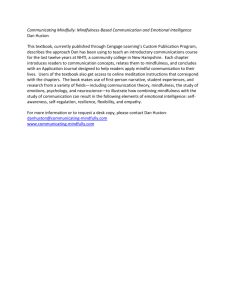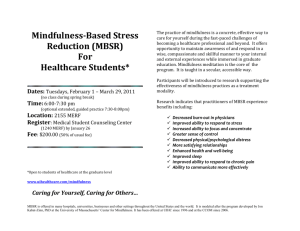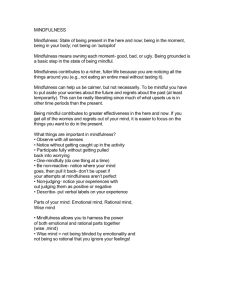Mindful Strategies for the Classroom
advertisement

B. Gurley Mindfulness … What is Mindfulness. What it’s not Mindfulness Research Why it works - brain & parasympathetic nervous system. Benefits for students with ED. Strategies Play Time Curriculum and recourses. Don’t Think… About A Purple Elephant! You Thought About A Purple Elephant! http://www.youtube.com/watch?v=Cm22OjwKcU8 :// What is Mindfulness “Mindfulness is a state of active, open attention on the present.” Psychology Today Is & Is Not Mindfulness-based teaching opportunities provide strategies for calming the mind, identifying false beliefs, and provide opportunities for attention and successful focus. Additionally, research has found that mindfulness helps with social abilities. Mindfulness is not a religion; however, every religious tradition promotes mindfulness and its benefits. Elements of Mindfulness In mindfulness meditation, the aim is to let thought be transitory and to keep coming back to the present moment. To let thinking be a thought without any particular meaning attachment. The identification of “this is who I am,” is removed and the thought becomes just a component of thinking, which can be easily accepted. Some Research Researchers Black and Sussman looked at 16 peer reviewed studies in their article Sitting-Meditation Interventions Among Youth: A Review of Treatment Efficacy and found “sitting meditation seems to be an effective intervention in the treatment of physiologic, psychosocial, and behavioral conditions among youth,” (Black and Sussman, 2009). More Research Rempel, (2012) researched the effectiveness of mindfulness-based therapies and correlated an analysis of results in Mindfulness for Children and Youth: A Review of the Literature with an Argument for School-Based Implementation. Counter-Intuitive Mindfulness & Being Social? It would seem that meditation and mindfulness would be counter-intuitive and not seen as building block for social skills for children with emotional disturbance and/or autism. After all, sitting alone crosslegged, and listening to the breath go in and out slowly from the nostrils is not exactly venturing out to “win friends and influence people. Children and Adolescents with Emotional Disturbances Over a decade ago, the U.S. Department of Health and Human Services reported that 21 percent of children 9 – to - 17 years of age in the U.S. have a diagnosable mental illness, (USDHHS, 2001). The Brain… How Mindfulness Has Been Used in Child & Adolescent Therapy Types of Mindfulness Therapy Current therapies that include mindfulness practice: • Mindfulness-Based Stress Reduction (MBSR) Mindfulness Based Cognitive Therapy (MBCT) Dialectical Behavior Therapy (DBT) Acceptance and Commitment Therapy (ACT). Mindfulness-Based Cognitive Therapy for Children (MBCT-C) The child therapy uses repetition, variety, active participation in performing tasks, such as mindfulness in moving, body scan, guided imagery and discussion groups. The environment is structured so that children are sitting in a circle on the floor with cushions. The aim of the structured group setting is to create “a cohesive, safe, and confidential environment – particularly during the initial sessions.” Teach Cognitive Awareness of Social Filters One of the strategies in the children’s course is to provide opportunities to reflect on social awareness and the missinterpretations that are often associated with social interactions. The strategy is used to explicitly teach cognitive awareness of social “filters.” Mindfulness for Children Strategy to categorize thoughts with mindfulness, “three states of mind:” Emotion mind – Recognize the emotions that are present. Reasonable mind - Recognize thinking errors • Wise mind – Understanding the ebb and flow of negative/positive thinking. Students are taught to experience the mind in terms of examining their thoughts and emotions with nonjudgmental, slow, and curious intent. An Example CBT The instructor reads… “You are walking down the street, and on the other side of the street you see somebody you know. You smile and wave. The person doesn’t seem to notice and walks by.” Mindfulness-Based Cognitive Therapy for Adolescents (MBCT-A) Adolescent’s Mindfulness Mindfulness is assisting teens in the… Removal of negative social judgments Improvement of communication Improvement in intimacy of primary relationships Reducing interpersonal risk avoidance Expanding interpersonal boundaries Assignment example For example, the thought - “no one likes me, I am really weird,’ is deconstructed in the wise mind, as – “hum there is that thought again. Look at it; it’s dark and repetitive – that’s a thought, which might be coming from the emotions. If I look at that thought from the logical mind, I discover there is no evidence at all I am more weird or less weird that most people. I see evidence that weird is just a side effect of being awesome. After all, it has been said that Einstein was weird. Really everyone has a little weird. Let me look at this thought from the wise mind again. Wise mind says, look at your body’s reaction to that thought, muscles are tight and there is a slight ache in your stomach. My body is telling me that this thought is toxic. Wise mind also says, there are hundreds and thousands of thoughts everyday that come into my mind. I don’t have to feel each and everyone of them.’ Strategies Breath (Sensory Yoga for Kids) Sound (Music) Smell Taste (Mindful Eating) Sight (Art Therapy) Body Awareness (Workbook) Apps Practice Eating a Raisin Bag Smells Stress Scale Visuals BioFeedBack Sensory Toys. Garrison Institute Go to http://www.garrisoninstitute.org/ Click Teaching and Learning Scroll to the bottom and click Database and?or Resources. The End



